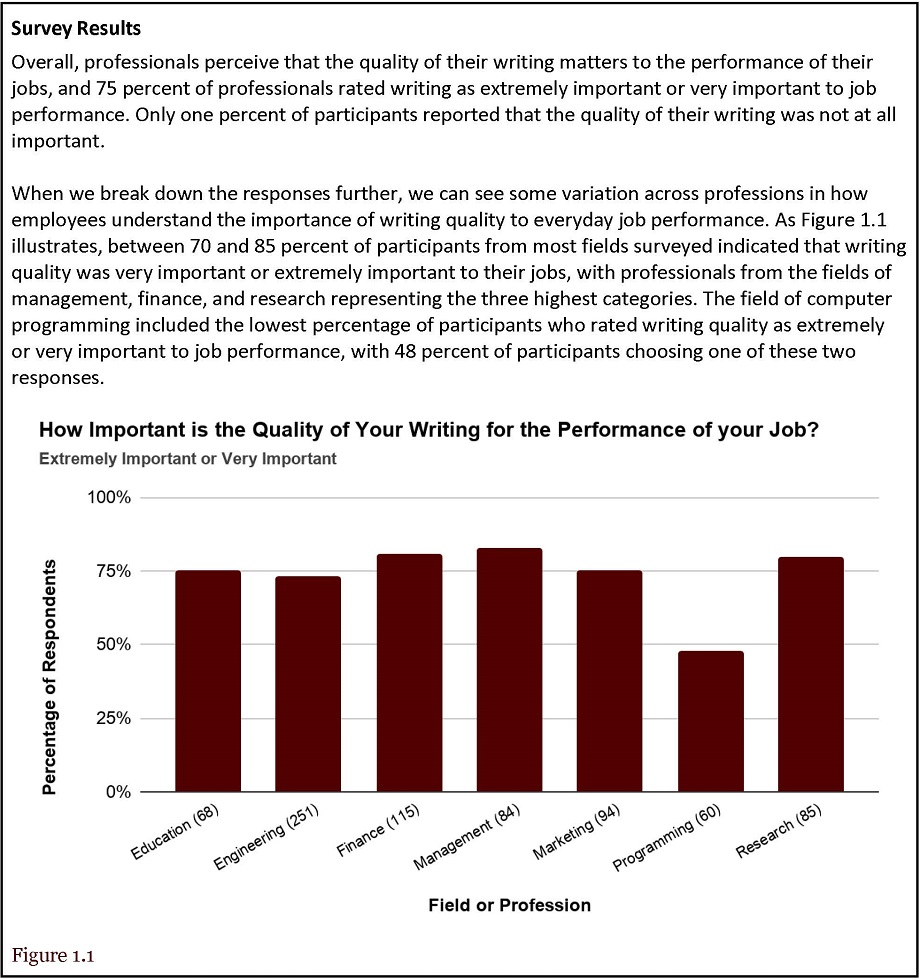20 – Recommendation Reports
Results
David McMurrey; Annemarie Hamlin; Chris Rubio; Michele DeSilva; Matt McKinney; and Nicole Hagstrom-Schmidt
Having detailed your research and project design choices for data collection in the methods section, a results section focuses on the actual collected data. As Chapter 19 notes when discussing lab reports, the results section typically provides brief descriptions of collected data and little else. However, some recommendation reports do not emphasize research (i.e. methods and results) to the same degree. Consequently, when you determine what to include in this section (or whether to include it at all), be mindful of your audience’s expectations and the conventions of your field or organization.
Unlike the introduction and methods sections of this recommendation report model, which focus heavily on your thoughts and choices as a researcher in framing your topic and investigation, your interpretations and thoughts on collected data should not be present in the results. Separating data and researcher interpretations presents the former objectively and allows the audience to observe any trends or patterns without the researcher’s influence. In some cases, such as scientific studies, this can make replication of the study easier; in other cases, it can be even more persuasive if the audience independently comes to the same conclusions as the researcher.
Refer to the example of results from Figure 20.8[1] below. Note how they delineate specific findings with basic descriptions without going into commentary. In the next section (the conclusions), the researcher will have the opportunity to expand on these descriptions and reflect critically on their research.

This text was derived from
Gross, Allison, Annemarie Hamlin, Billy Merck, Chris Rubio, Jodi Naas, Megan Savage, and Michele DeSilva. Technical Writing. Open Oregon Educational Materials, n.d. https://openoregon.pressbooks.pub/technicalwriting/. Licensed under a Creative Commons Attribution-NonCommercial-ShareAlike 4.0 International License.
McMurrey, David. Online Technical Writing. n.d. https://www.prismnet.com/~hcexres/textbook/. Licensed under a Creative Commons Attribution 4.0 International License.
Swarts, Jason, Stacey Pigg, Jamie Larsen, Julia Helo Gonzalez, Rebecca De Haas, and Elizabeth Wagner. Communication in the Workplace: What Can NC State Students Expect? North Carolina State University Professional Writing Program, 2018. https://docs.google.com/document/d/1pMpVbDRWIN6HssQQQ4MeQ6U-oB-sGUrtRswD7feuRB0/edit#heading=h.n2a3udms5sd5. Licensed under a Creative Commons Attribution 4.0 International License.
- Kalani Pattison, "Excerpt from the Body of a Technical Report Describing Results from Research," 2022. Licensed under a Creative Commons Attribution-NonCommercial-ShareAlike 4.0 International License. Figure derived from Jason Swarts, Stacey Pigg, Jamie Larsen, Julia Helo Gonzalez, Rebecca De Haas, and Elizabeth Wagner, Communication in the Workplace: What Can NC State Students Expect? (Raleigh: North Carolina State University Professional Writing Program, 2018), https://docs.google.com/document/d/1pMpVbDRWIN6HssQQQ4MeQ6U-oB-sGUrtRswD7feuRB0/edit#heading=h.n2a3udms5sd5. Licensed under a Creative Commons Attribution 4.0 International License. ↵
